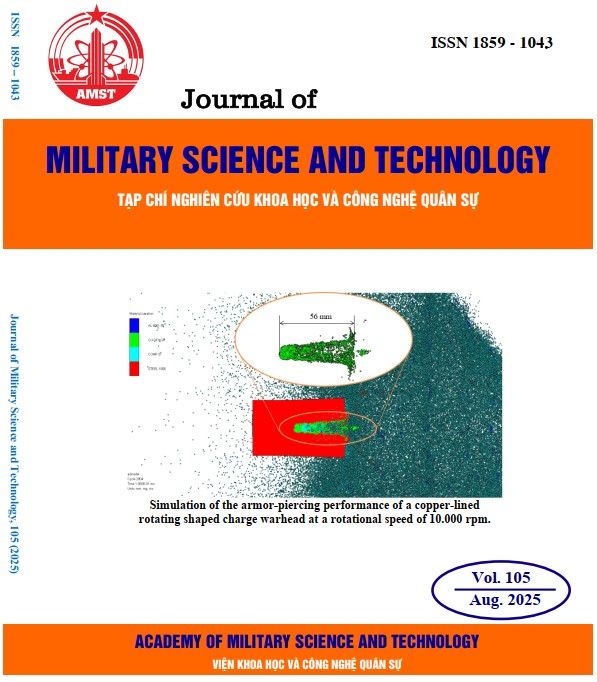Nghiên cứu phương pháp đánh bóng hai bước bằng laser xung sợi quang cho chi tiết thép dụng cụ SKD11
351 lượt xemDOI:
https://doi.org/10.54939/1859-1043.j.mst.105.2025.155-162Từ khóa:
Đánh bóng; Laser xung; Thép dụng cụ SKD11; Đánh bóng hai bước.Tóm tắt
Trong nghiên cứu này, nhóm tác giả đề xuất và áp dụng một kỹ thuật đánh bóng hai bước bằng laser xung sợi quang công suất trung bình cho vật liệu khuôn dập nguội bằng thép SKD11. Mục tiêu nhằm cải thiện độ bóng bề mặt sau phay thông qua phương pháp đánh bóng bằng laser có tính chính xác và tiềm năng tự động hóa cao. Các thí nghiệm được tiến hành bằng việc sử dụng nguồn laser xung sợi quang công suất tối đa 35 W, bước sóng 1064 nm, kết hợp với đầu quét galvo và hệ thống điều khiển số. Các mẫu được đánh bóng dưới khí bảo vệ argon với nhiều thông số quét khác nhau. Nghiên cứu tập trung khảo sát ảnh hưởng của công suất laser và số lần quét đến cấu trúc bề mặt, độ nhám và tổ chức tế vi gần bề mặt. Kết quả cho thấy, khi áp dụng kỹ thuật đánh bóng hai bước – bước đầu dùng laser công suất cao (35 W) để loại bỏ các đỉnh nhấp nhô lớn, bước tiếp theo dùng laser công suất thấp hơn (21 W) để làm mịn các vùng lồi lõm nhỏ – độ nhám bề mặt Ra giảm từ ~ 4.5 µm xuống còn ~ 1.2 µm (~ 73%). Tổ chức tế vi sau đánh bóng có sự thay đổi pha tại lớp bề mặt, thể hiện qua sự hình thành vùng tổ chức austenite do ảnh hưởng của xung laser năng lượng cao. Nghiên cứu góp phần làm rõ hiệu quả của kỹ thuật đánh bóng hai bước bằng laser xung đối với vật liệu khó gia công như SKD11, mở ra triển vọng ứng dụng công nghệ này trong chế tạo khuôn chính xác và tự động hóa gia công.
Tài liệu tham khảo
[1]. Chen, H. et al, "Effects of laser shock peening on the properties and microstructure evolution of laser-polished surface of Cr12 steel", Journal of Laser Applications, 33 (3), 032001, (2021). DOI: https://doi.org/10.2351/7.0000395
[2]. Liu, E. et al, "Surface morphology evolution and tribological behavior in nanosecond pulsed laser polishing of S136 mold steel", Journal of Materials Research and Technology, 22, 3230-3244, (2023). DOI: https://doi.org/10.1016/j.jmrt.2022.12.153
[3]. Liu, Z. et al, "Surface morphological evolution and microhardness change of Cr12MoV steel by pulsed laser polishing", Optics & Laser Technology, 171, 110419, (2024). DOI: https://doi.org/10.1016/j.optlastec.2023.110419
[4]. Ukar, E. et al, "Laser polishing of tool steel with CO2 laser and high-power diode laser", International Journal of Machine Tools and Manufacture, 50 (1), 115-125, (2010). DOI: https://doi.org/10.1016/j.ijmachtools.2009.09.003
[5]. Gwon, H. et al, "Martensitic transformation during electrochemical polishing of metastable austenitic stainless steel", Acta Materialia, 245, 118612, (2023). DOI: https://doi.org/10.1016/j.actamat.2022.118612
[6]. Deng, T. et al, "Influence of plasma beam polishing process parameters on surface roughness of AISI 304 stainless steel", Applied Surface Science, 585, 152741, (2022). DOI: https://doi.org/10.1016/j.apsusc.2022.152741
[7]. Hocheng, H. et al, "Fundamental study of ultrasonic polishing of mold steel", International Journal of Machine Tools and Manufacture, 42 (1), 7-13, (2002). DOI: https://doi.org/10.1016/S0890-6955(01)00099-2
[8]. Gisario, A. et al, "Laser polishing: a review of a constantly growing technology in the surface finishing of components made by additive manufacturing", The International Journal of Advanced Manufacturing Technology, 120 (3), 1433-1472, (2022). DOI: https://doi.org/10.1007/s00170-022-08840-x
[9]. Lu, H. et al, "A review of laser polishing on Ti6Al4V based on energy density", Journal of Materials Processing Technology, 331, 118520, (2024). DOI: https://doi.org/10.1016/j.jmatprotec.2024.118520
[10]. Kanishka, K. et al, "Revolutionizing manufacturing: A comprehensive overview of additive manufacturing processes, materials, developments, and challenges", Journal of Manufacturing Processes, 107, 574-619, (2023). DOI: https://doi.org/10.1016/j.jmapro.2023.10.024
[11]. Ross, I. et al, "Laser Polishing of Cold Work Steel AISI D2 for Dry Metal Forming Tools: Surface Homogenization, Refinement and Preparation for Self-Assembled Monolayers", Key Engineering Materials, 767, 69-76, (2018). DOI: https://doi.org/10.4028/www.scientific.net/KEM.767.69
[12]. Cao, Z. et al, "Ground fused silica processed by combined chemical etching and CO2 laser polishing with super-smooth surface and high damage resistance", Opt. Lett., 45 (21), 6014-6017, (2020). DOI: https://doi.org/10.1364/OL.409857
[13]. Zhang, X. et al, "Polishing of alumina ceramic to submicrometer surface roughness by picosecond laser", Surface and Coatings Technology, 397, 125962, (2020). DOI: https://doi.org/10.1016/j.surfcoat.2020.125962
[14]. Ukar, E. et al, "An industrial approach of laser polishing with different laser sources", Materialwissenschaft und Werkstofftechnik, 46 (7), 661-667, (2015). DOI: https://doi.org/10.1002/mawe.201500324
[15]. Lesyk, D. A. et al, "Surface microrelief and hardness of laser hardened and ultrasonically peened AISI D2 tool steel", Surface and Coatings Technology, 278, 108-120, (2015). DOI: https://doi.org/10.1016/j.surfcoat.2015.07.049
[16]. SteelJIS: Japanese Steels and Alloys, “SKD11: Chemical composition, standards and properties”. https://steeljis.com/jis_steel_datasheet.php?name_id=159
[17]. Meng, Y. et al, "Effects of subsequent treatments on the microstructure and mechanical properties of SKD11 tool steel samples processed by multi-stage thixoforging", Materials Science and Engineering: A, 762, 138070, (2019). DOI: https://doi.org/10.1016/j.msea.2019.138070
[18]. Kang, E. G. et al, "Austenite phase transformation of SKD11 by surface heat treatment with a focused electron beam", Surface and Coatings Technology, 321, 247-256, (2017). DOI: https://doi.org/10.1016/j.surfcoat.2017.03.042
[19]. Kitamura, Y. et al, "Nanostructured tool steel fabricated by combination of laser melting and friction stir processing", In Proceedings of the 1st International Joint Symposium on Joining and Welding, Fujii, H. Ed.; Woodhead Publishing, pp 377-381, (2013). DOI: https://doi.org/10.1533/978-1-78242-164-1.377







